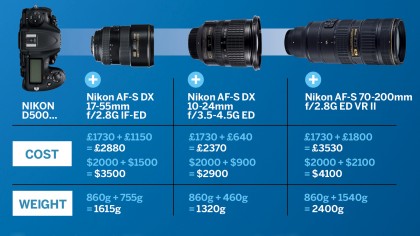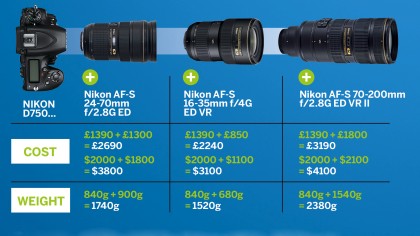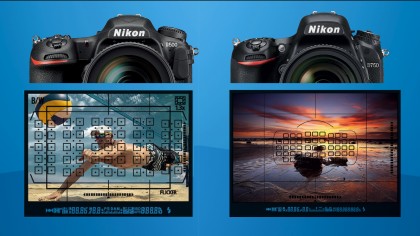Nikon D500 vs Nikon D750: Which DSLR should you choose?
Who really needs a full-frame DSLR?
5. Size, weight and cost

This is where you might expect Nikon's DX cameras to have an advantage, and they do at the beginners' end of the market. But once you start looking at more advanced models the differences quickly disappear. Indeed, the D500's body is slightly larger than the D750's, not smaller. It's true that DX lenses are generally smaller than their FX counterparts and less expensive, but that's partly because there is a dearth of pro-quality constant-aperture zooms at shorter focal lengths for the DX format. Variable-aperture lenses are lighter and cheaper partly due to their lower spec.

You might assume that an FX-format Nikon system would be bigger, heavier and more expensive, but there's more going on than just an increase in size. In fact, the range of lenses available for the DX and FX formats is not directly equivalent. Direct lens comparisons are difficult because most DX-format lenses are designed for cost-conscious consumers, while most FX-format lenses are designed for quality-conscious pros. Our tables compare like-for-like lenses as closely as we can get them, but there are important differences in the three key lens areas we've chosen. What it boils down to is that DX gives you the value, but FX gives you the choice.
6. Autofocus
Interestingly, Nikon DX and FX cameras use the same basic autofocus sensor modules, with only small modifications for the different formats. This means that autofocus advances happen across both formats – the D500 has essentially the same brand-new state-of-the-art autofocus system as the flagship Nikon D5.
But there is a further bonus for DX Nikon users: because the sensor area is smaller, the area covered by the autofocus sensor stretches right to the edge of the frame. For sports/action photography, the D500 comes out a clear winner partly because of its autofocus system.

The D750 uses Nikon's older and less sophisticated 51-point autofocus system. It's still very fast and powerful, even today, but not in the same league as the D500's new 20K AF module. The key difference is not just the number of autofocus points, however, but their distribution.
The D750 has a larger sensor area, with the result that the autofocus sensor area does not reach right to the edges of the frame. It's not necessarily an issue for general photography, since most shots are composed with the main subject near the centre of the frame, but it could prove an issue with erratic, fast-moving subjects.
D500 AF system:
- Multi-CAM 20K autofocus sensor module
- 153 AF points, including 99 cross-type
- Single-point AF, 25-, 72-, or 153-point dynamic-area AF, 3D-tracking, group-area AF, auto-area AF
D750 AF system:
- Multi-CAM 3500 II autofocus sensor module
- 51 AF points including 15 cross-type
- Single-point AF; 9-, 21- or 51-point dynamic-area AF, 3D-tracking, group-area AF, auto-area AF
Get daily insight, inspiration and deals in your inbox
Sign up for breaking news, reviews, opinion, top tech deals, and more.
Current page: D500 vs D750: Autofocus
Prev Page D500 vs D750: Depth of field Next Page D500 vs D750: Conclusion
Rod is an independent photographer and photography journalist with more than 30 years' experience. He's previously worked as Head of Testing for Future’s photography magazines, including Digital Camera, N-Photo, PhotoPlus, Professional Photography, Photography Week and Practical Photoshop, and as Reviews Editor on Digital Camera World.